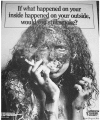Process evaluation of an in-school anti-tobacco media campaign in Louisiana
- PMID: 19711659
- PMCID: PMC2556723
- DOI: 10.1177/003335490812300614
Process evaluation of an in-school anti-tobacco media campaign in Louisiana
Abstract
Objectives: In light of challenges imposed by the changing media landscape and decreasing classroom time available for health interventions, new approaches are needed to disseminate anti-tobacco messages to adolescents. This study reported process evaluation of an in-school three-year anti-tobacco media campaign conducted in 10 schools in Louisiana.
Methods: Over three years, 10 schools received an in-school anti-tobacco media campaign. The media campaign was one intervention component of the Acadiana Coalition of Teens against Tobacco. Campaign measures were tracked over the campaign's three-year duration. The campaign and evaluation were designed to target the students as they progressed through high school. The number of students who completed the surveys were 1,823 in Year 1, 1,552 in Year 2, and 1,390 in Year 3. Schools eligible for participation were publicly funded schools with no magnet or special populations and within a two-hour driving distance of the New Orleans study office.
Results: In a self-report survey (Year 1, n = 1,823; Year 2, n = 1,552; Year 3, n = 1,390), more than 75% and 50% of students reported being exposed to posters and public service announcements, respectively. Recognition of campaign theme was more than 80%. Almost half of respondents reported that the posters were interesting, one-third reported that the posters prevented them from smoking, and 10% reported that the posters encouraged them to cease smoking. Stock media posters had a significantly higher affective reaction than the customized media posters.
Conclusion: Findings suggest that in-school media programs are useful and should be considered as a viable approach to health education for adolescents.
Figures





References
-
- Johnston LD, Terry-McEllrath YM, O'Malley PM, Wakefield M. Trends in recall and appraisal of anti-smoking advertising among American youth: national survey results, 1997–2001. Prev Sci. 2005;6:1–19. - PubMed
-
- Pechmann C. Does antismoking advertising combat underage smoking? A review of past practices and research. In: Goldberg ME, Fishbein M, Middlestadt S, editors. Social marketing: theoretical and practical perspectives. 189–216. Hillsdale (NJ): Lawrence Erlbaum Associates; 1997.
-
- Wakefield M, Szczypka G, Terry-McElrath Y, Emery S, Flay B, Chaloupka F, et al. Mixed messages on tobacco: comparative exposure to public health, tobacco company- and pharmaceutical company-sponsored tobacco-related television campaigns in the United States, 1999–2003. Addiction. 2005;100:1875–83. - PubMed
-
- Hong T, Cody MJ. Presence of pro-tobacco messages on the Web. J Health Comm. 2002;7:273–307. - PubMed
Publication types
MeSH terms
Grants and funding
LinkOut - more resources
Full Text Sources
Medical

